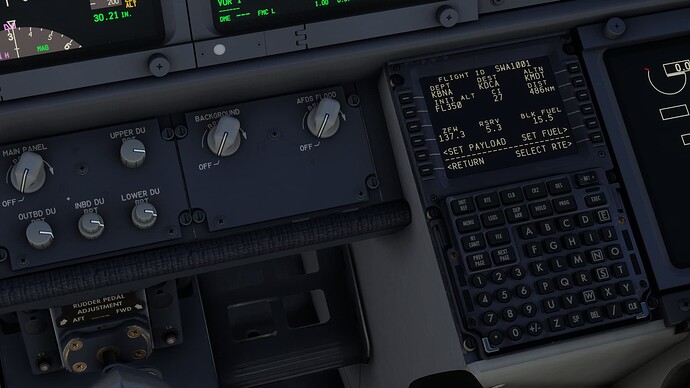Where are these hiding?
Before you enter the route via the ‘RTE’ press
Thank you.
Keep in mind that they will only show up after you import the simbrief route in the tablet.
After requesting via the tablet:
On the POS INIT screen, press ROUTE:
Then next to FLT PLAN, REQUEST:
Select your Simbrief plan:
SET PAYLOAD and SET FUEL:
Thank you. I’d not been given the direct link to SimBrief initially and had to import the FP from my PC. I dunno why that was.
I see direct SimBrief import now, though.
Next question: When I click Perf Init > Request and review the changes, it still wants to alter the Reserves from 2.2 up to 5.2. What’s up with that?
This is a good one for the 737 type-rated guys to answer - if I am entering fuel reserves and such manually, I don’t use the FMS’s REQUEST feature at all. The Reserves is an advisory level - if the plane thinks it’s going to use some of that during the planned trip, you’ll see the INSUFFICIENT FUEL warning on the display.
I have lately not been bothering doing any of this manually and just requesting the PERF INIT data from the FMC. As I understand it, the RESERVES entry is the combination of FAR RESERVE and ALTERNATE fuel weights from your OFP. For the flight I just loaded up, those values are 2.5 and 2.8, which total 5.3. That is what the PERF INIT page loaded in after I pressed REQUEST.
Thank you so much for your help. I love this community for all the collective support of one another.
Does this set all the Wind data, too, or is that a separate step?
From the FMC “Legs” page at the bottom (I believe it is route data) you can request that.
Then go to the descent page and add the descent forecast.
You can request wind data in the descent page as well
Aside: I find it interesting that the 737NG only uses Descent Winds, whereas the 777, 787, and I think the 747 use Climb, Cruise, and Descent. Guessing the descent is most important of the three for correctly calculating VNAV descent path, while the others are “nice to have”, and the overarching “Cruise Wind” is good enough for estimating ETA.
If you import a Simbrief flight plan into the PMDG 737 EFB, you will have winds aloft forecasts available for each and every waypoint in your FP. (Loaded via the FMS LEGS page). It can make a significant improvement in time enroute and fuel burn predications.
Hmm…these waypoint wind forecasts are automatically loaded when you import a SB plan, or I have to take some action?
You need to import them, as mentioned above.
Go to the LEGS page in the FMC and request the data, which you’ve loaded into the tablet earlier.
Thanks all…the “secret menu” lol. Makes me wonder what else I’ve missed all this time in the FMC. I need some remedial YouTube sessions from Emi, et al.
Pretty sure they all use the enroute winds for ETA and fuel burn calculations?
Late to the conversation here as the recent questions above have been answered. FWIW, here is my procedure flow for Xbox Series X, however the PMDG stuff should be the same (the steps in the square brackets are key binds to hardware):
PREFLIGHT (B737/738)
- Cntl 3: PMDG, LOAD PANEL
- Cntl 3: FSA, Ground Services
- JETWAY REQ, RETURN
- RETURN, FMC, CLR
- Cntl 9: EFB, Req SimBrief
- TURN OFF TABLET
- Cntl 3: POS INIT> ROUTE>
- FLT PLAN REQUEST> <RTE
- <SET PAYLOAD, SET FUEL>
- SELECT RTE> REQUEST
- <LOAD, RWY, ACTIVATE> EXEC
- DEP: SID, RWY EXEC>
- ARR: STAR, RWY, EXEC>
- LEGS: STEP through/fix
- INIT REF: PERF INIT REQUEST>
- Wait! <LOAD, EXEC, N1 LIMIT
- TAKEOFF> FLAPS, CG, V1, Vr
- Cntl 1: Set V2 on MCP
- [B], [FD], [A/T] [A/T] Arm,
- [NAV], VNAV, [ALTITUDE]
- Stabilizer Trim SET
- [Park brake] [Park brake]
- DSC: <FORECAST <REQUEST
- Wait: LOAD> EXEC, LEGS
- FSA: GROUND SVCS
Over time I have found that some of these steps can be done in a different sequence with the same effect; the flow I settled on minimizes panning and scrolling around the flight deck on my particular set-up. Others may prefer to sequence some steps differently based on their gear.
Hope this helps someone out there. Good flying!
I decided to tinker a bit with an INOP APU for the 737, and practice using an air start + cross bleed start. I quickly found out that an air cart + battery power alone is not sufficient, and that you still need ground power when doing the first engine start.
So in real-world ops, I would guess that you would not typically start a plane’s engines at the gate/stand. So I assume stay at the gate with GPU to get everything set up, then disconnect GPU, stay on battery power as you push back, chock the plane, call a GPU cart and a Air Cart, start engine 1, turn on Gen 1, then disconnect the two carts and remove chocks, then do cross-bleed start for #2? Or do some operators or airports allow you to start engine one at the gate with GPU + Air cart, then pushback and cross-bleed start the other engine?
Two other observations:
- The beacons and nav lights did not work on just battery power for the pushback.
- GSX won’t let you push back with a) your APU inactive, and b) your engines running…glad I have the pushback toolbar as a backup.
Always something new to learn in today’s world of flight simming!
The APU not only provides electricity, it also provides compressed air



